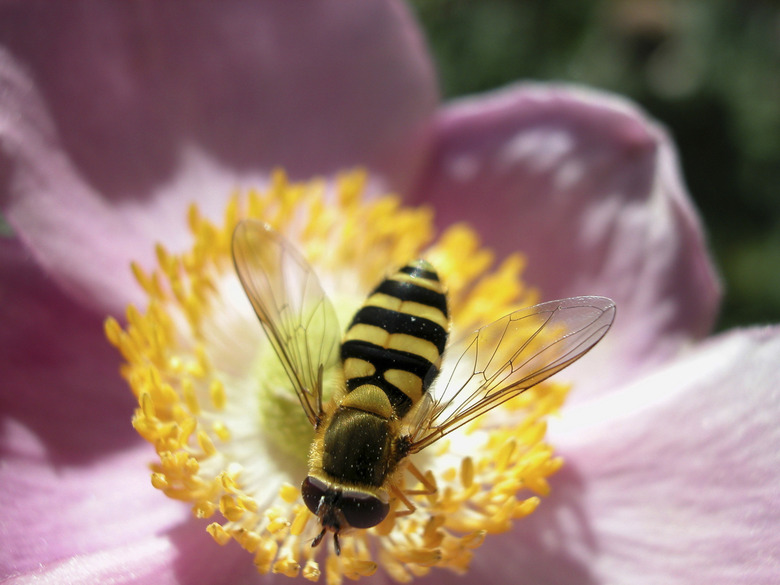Examples Of Synergy In Nature
What does synergy mean? Synergy is broadly defined as the combined efforts of two or more organisms to produce a greater result than each would achieve individually. Types of synergistic relationships in nature include altruism, reciprocity, functional interdependence, mutualism and parasitism.
Mutualistic relationships are one type of synergy that occurs between two species who perform "services" for each other that they can't carry alone. For example, a bee gets its food from a flower's nectar and the flower is fertilized by pollen carried by the bee during pollination. This kind of interaction is found in various types of environments: the ocean, on land, in bacteria and even the human intestine.
Oxpeckers and Zebras
Oxpeckers and Zebras
One example of mutualism is the relationship between zebras and very small birds called African oxpeckers. The zebras have two sources of food for the oxpeckers – the ticks on their backs and their blood that the birds suck out of wounds from tick bites. However, the zebras' blood loss from oxpeckers is relatively small.
Oxpeckers act as a pest control but also make a hissing sound whenever they're frightened. This makes them an alarm system for the zebras, so they can move to a safer area whenever the oxpeckers see a nearby predator. The oxpecker also has this relationship with the rhinoceros.
Sea Anemones and Others
Sea Anemones and Others
Sea anemones have mutualistic relationships with other species on the ocean floor. They can be found on the backs of hermit crabs, and both fend off predators: Anemones repel octopuses trying to eat the crabs and the crabs repulse starfish preying on anemones.
Clownfish also have a mutualistic relationship with sea anemones. The anemones repel clownfish predators by stinging them with their tentacles. A protective layer on the clownfish's skin protects them from the sting. At the same time, clownfish scare off butterfly fish that try to eat the anemones.
Fungi with Insects
Fungi with Insects
Fungi have a mutualistic relationship with several insect species in forested habitats. Beetles and ants "farm" fungi: they help grow them by collecting and grinding up leaves and feeding the leaves to the fungi. They then use the fungi for food.
This synergistic interaction is mutualistic because, although the insects consume the fungi, they also help the fungi populations to increase by providing them with nutrition. However, fungi aren't completely dependent on ants or beetles: their spores can float elsewhere to live a more independent lifestyle.
Bats and Fig Trees
Bats and Fig Trees
In the synergistic relationship between bats and fig trees, both species benefit, so it is mutualistic. Fruit bats help to spread the seeds of figs after eating the fruits, as the seeds are ingested with the flesh of the figs and dispersed when bats excrete waste products.
Intestinal Bacteria of Mammals
Intestinal Bacteria of Mammals
Bacteria are found in various species' intestines where they get food from helping to break down digestible materials. In moose, bacteria are needed to break down the massive amounts – around 160 liters – of plant material in the intestine. These bacteria have an ample supply of nutrition from aiding digestion.
This type of bacteria is also found in the human small intestine where it helps break down the food humans consume. Humans have a mutualistic relationship with these bacteria because humans indirectly feed these bacteria when they eat food.
Hosts and Beneficial Viruses
Hosts and Beneficial Viruses
Most viruses are harmful, but some viruses have a mutually beneficial relationship with their hosts. A lot of viruses help their hosts by attacking their competition. For example, the hepatitis G virus slows down the growth of HIV, the virus that causes AIDS in humans.
Bacteria grow viruses inside their cells and infect competitors with those viruses. Other viruses are needed for their host's physical development. When wasps lay eggs inside other insects, their eggs are equipped with viruses. These viruses fight off the infected insect's defenses and guarantee the eggs' survival.
Cite This Article
MLA
Auerbach, Scott. "Examples Of Synergy In Nature" sciencing.com, https://www.sciencing.com/examples-synergy-nature-12322176/. 30 September 2021.
APA
Auerbach, Scott. (2021, September 30). Examples Of Synergy In Nature. sciencing.com. Retrieved from https://www.sciencing.com/examples-synergy-nature-12322176/
Chicago
Auerbach, Scott. Examples Of Synergy In Nature last modified March 24, 2022. https://www.sciencing.com/examples-synergy-nature-12322176/
